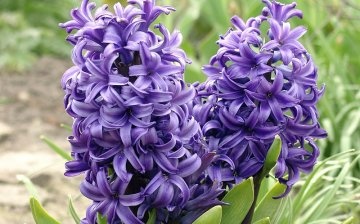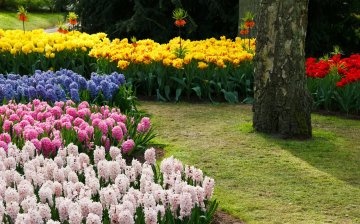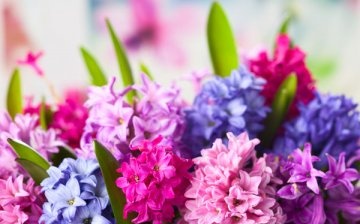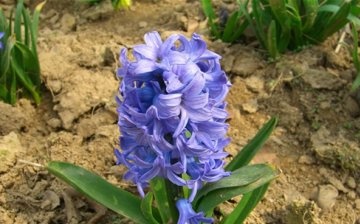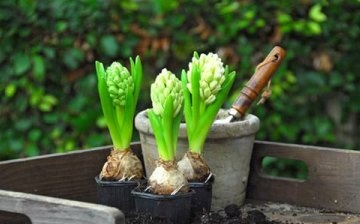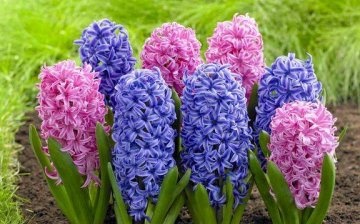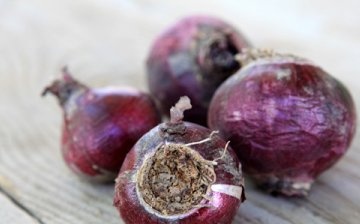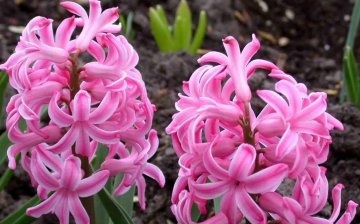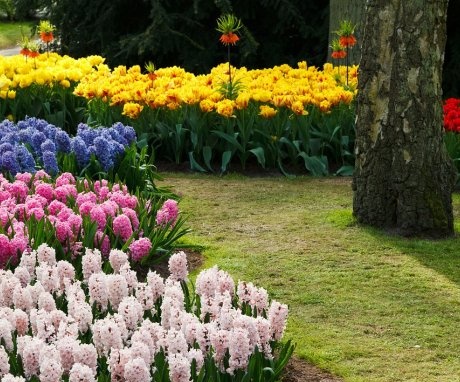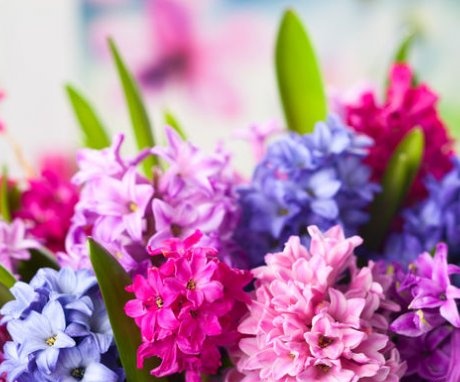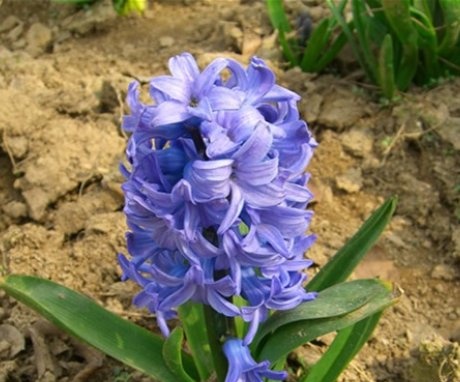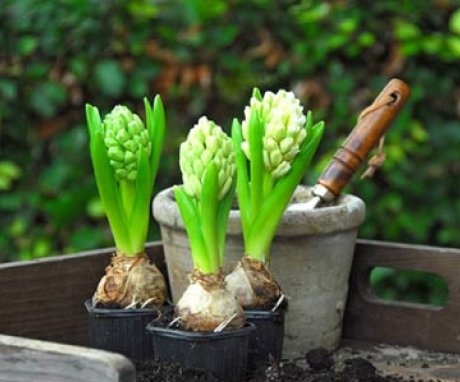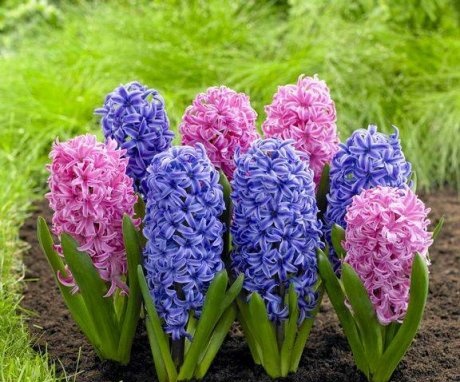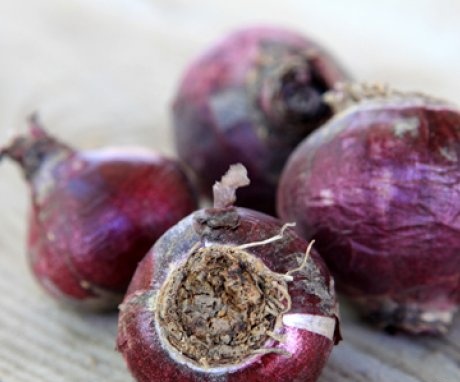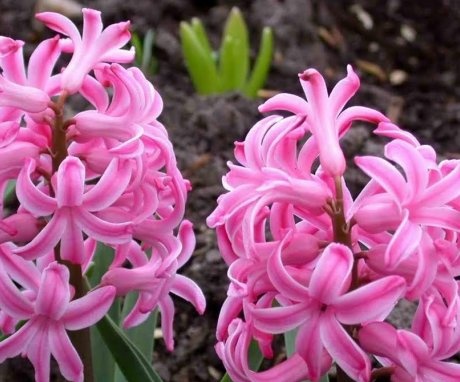Planting and proper care of hyacinths in the garden
When the garden is just beginning to awaken hyacinth already throws out lush and bright inflorescences. Glades with early spring flowers adorn the still dull area, cheer up and make you admire the dense carpet of fragrant flowers.
Often low-growing hyacinths are combined with tulips in the background so that the colors are favorably shaded with greens. Planting bulbs is not particularly difficult, but in the case of hyacinth, it is recommended to follow agricultural techniques, which are somewhat different from, for example, planting and caring for tulips. From the material, the gardener learns not only about the features of growing hyacinth, but also about care, popular varieties, types and methods of reproduction.
Content:
- Description of hyacinth
- Varieties and types
- Growing conditions
- Planting bulbs
- Hyacinth care
- Storing the bulbs
- Diseases and pests
Description of hyacinth
Hyacinths belong to the Asparagus family. They are perennial bulbous plants. The homeland of flowers is Asia, its southeastern part and the Mediterranean. In the wild, they are found in the southern part of the Caucasus. The plant develops from a bulb consisting of many scales.
The leaves are collected in a rosette, narrow, directed upwards. The peduncle reaches a height of 45-50 cm, depending on the species and variety, leafless. The top of the peduncle is covered with bell-shaped inflorescences, the blades of which are bent. The color palette of colors is varied - white, red, pink, blue, yellow, lilac. The plant blooms early - in April or early May. The fruit is three-nested, with two seeds in each compartment. Propagated by children and seeds.
Hyacinths are used for landscape decoration - mixborders, spring beds, rabatki.
Flowers occupy a special place in floristry. They are grown in greenhouses, breeders have successfully developed varieties specifically for cutting, which are easy to distill. The plant stands in bouquets for a long time. Many people grow hyacinth at home, but its widest use is in the garden and for creating flower arrangements.
Varieties and types
There are over 450 varieties of hyacinth. This diversity is based on three plant species, with the help of which breeders are breeding all new hybrids. There are the following types included in the official classification:
- Hyacinth Litvinova
- Transcaspian
- Oriental
Varieties, hybrids and other varieties of hyacinth are subdivided on the basis of flowering time, flower shape and color palette of inflorescences. Allocate early, middle and late plants, simple and double. The range of shades includes colors:
- Blue - popular varieties of this range include "Pearl Brilliant" (late, blue), "Marie" (early, dark blue), "Queen ov ve bluz" (medium-flowering, light blue with aroma).
- Lilac - the most spectacular varieties of this range include "Bismarck" (early, pale violet), "Blue Magic" (mid-flowering, purple-violet), "Indigo King" (late, dark violet).
- Pink - well-known varieties of pink range include "Moreno" (early, crimson shade), "Anna Marie" (mid-flowering, pink), "Gertrude" (late, dark pink).
- Red - impressive varieties "La Victoire" (late, light red), "Scarlet Tubrgensa" (mid-flowering, bright red), "Kholikhok" (late, red-crimson, terry).
- White - beautiful snow-white hyacinths "Snow crystal" (late), "Madame Sophie" (mid-flowering).
- Yellow and orange - "Orange Bowen" (medium-flowering, delicate apricot shade), "Yellow Hammer" (medium-flowering, bright yellow).
Separately, it is worth mentioning the variety "Krasnodar", beautiful double flowers of a delicate lilac shade, medium-flowering, delight with flowering for about three weeks. "Sunflower" is recommended for lovers of double, large flowers of a pale yellow shade with a creamy undertone. This variety of hyacinth belongs to the late group. "Jan bos" surprises with a bright, rich beet-red hue, belongs to the early group. These varieties are loved to be used in landscaping, they are used in order to form a bright spot in flower beds and attract attention.
Select species and varieties based on the growing region and flowering time.
You can pick up both early and middle and late groups hyacinths for full bloom throughout the spring season. Keep in mind that yellow flowers always bloom last, blue flowers first.
Growing conditions
Hyacinth loves sunny areas, sheltered from northerly winds. It is better not to grow it in lowlands or depressions; waterlogged soil will lead to rotting of the bulbs.
If there is no flat place on the site, the ground is always damp, it is recommended to make a comb for hyacinths. So the soil will be loose and moderately moist. The best option for a plant site is a sunny meadow on a hill, protected by a hedge or a building, a fence on the north side so that the shadow does not obscure the plants.
The main conditions for successful cultivation are a bright, sheltered place and light, loose soil.
The soil mixture is loose, fertile. Mix leaf earth, turf and humus in a 1: 1: 1 ratio. Heavy soils are diluted with coarse sand. Complexes are introduced into the ground before landing without fail mineral fertilizers: superphosphate, potassium sulfate and wood ash. If the soil is acidic, it must be limed. Hyacinth prefers neutral soil pH. The soil is prepared a month before planting the bulbs.
Planting of bulbs is carried out only in autumn - the second half of September, early October. The soil temperature is 7 ° -9 °. The depth of the trench for the bulbs is about 20-25 cm. If the site is in the lowland, make a special ridge-comb so that, taking into account the frost, the bulbs do not freeze. The soil should be moist and already prepared in advance, enriched with fertilizers. Before planting, the bulbs must be kept in a fungicide solution for no more than 30 minutes.
It is better to plant the seed in a sand jacket. A layer of sand is poured into the bottom of the hole or trench, the bulb is slightly pressed into it and again covered with sand. The shirt is covered with soil. This measure allows you to protect the bulbs from rotting and damage by fungal diseases.
The distance between the children when planting is up to 10 cm, between the bulbs - up to 15 cm.
20-30 cm are left between the ridges or rows, depending on the variety. Always consider the timing of germination. They are two to three weeks. If the bulbs are planted too early, they will start to grow and die in winter, too late - they will not have time to take root.
After planting the ground mulch and covered with spruce branches. The latter can be excluded for the southern regions. The height of the mulch reaches 15 cm, sawdust, and mowed grass and humus are also used. In the spring, it must either be removed or carefully embedded in the soil. For five years, hyacinths have been planted in different places. Thus, the plant will return to its original area after 5 years.
Hyacinth care
The culture, if planted taking into account all agrotechnical requirements, does not require special care:
- Watering... Hyacinth does not require abundant watering, as it does not like waterlogging of the soil. Water only when the topsoil dries up. More frequent watering occurs during and after the flowering of the plant - the bulbs should gain strength for the next season. During the formation of leaves and peduncles, there is enough moisture from melt water. No watering required.
- Top dressing... Top dressing plays a more important role than watering. The first fertilization is carried out as soon as the greens have started to grow. Nitrate and superphosphate are used in the proportions indicated on the fertilizer packages. The second application falls on the period of plant budding. Superphosphate and potassium sulfate are used. At the end of flowering or after it, the same fertilizers are applied as during the budding period. Fertilizer rates are indicated in the instructions for them. Complex mineral fertilizers... Usually, dry preparations are introduced, which are carefully embedded in the soil. If a liquid form of fertilizer is preferred, water the soil abundantly and apply solutions between the rows of plants first. The bulbs absorb nutrients within a radius of 20-25 cm.
- Weeding. Hyacinth is considered a very "hygienic" plant, it does not tolerate weeds and garbage next to you. It is very important to promptly remove weeds, faded inflorescences. The soil must be loosened - prevention of the appearance pestswho are not averse to feasting on the pulp of the onions. The hyacinth bed should always be clean.
The rules of care are simple, the main points are weeding and feeding the plants. Watering is carried out rarely, during periods of drought, which happens quite rarely in spring.
Storing the bulbs
Hyacinth bulbs must be dug out after flowering... As soon as the leaves turn yellow, you can collect seed for the fall. The bulbs are examined for rotting or fungal infections. If there are children on the plant, they are left to grow - this material is used to multiply the culture.
After harvesting, the bulbs are washed, ventilated and dried for a week.
Then they are folded in one layer in wooden boxes and put away in a warm place with a temperature of about 30 ° for 1.5 months. Then they are moved to a place where the temperature is much lower - about 16 ° before landing. Before planting, it is advisable to take the bulbs to the garden to adapt to the temperature.
Diseases and pests
The most dangerous and unpleasant ailments of the plant are white, yellow and soft rot. The disease affects not only the aerial part, but also the bulb. Culture is dying. Rot can be determined by yellowed leaves, dark spots, the plant stops growing. The bulbs become soft and either yellow or white. A very unpleasant odor appears. In this case, the culture is destroyed, and nothing is planted on the site. The soil is disinfected and treated with chemicals. The most common pests of hyacinths include:
- Onion fly (larvae are dangerous).
- Onion tick.
- Wireworm.
- Stem nematode.
It is very difficult to get rid of parasites, since their larvae are in the ground and destroy the bulbs. Therefore, prevention is considered the most effective control method - preparation of bulbs and soil before planting. The first ones are kept in solution fungicidesuch as karbaphos or rogor. They bring into the soil wood ash or lime, loosened during the growing season. Be sure to sort out the dug out bulbs and discard the affected ones.
In the place where hyacinths grew, plant marigold, tomatoes or delphiniums.
Sometimes you can notice such a phenomenon as the falling of the peduncle from the nest. Many believe that this is a manifestation of some kind of disease, but these are just flaws in caring for the plant. This happens when the soil is waterlogged or the bulbs were not well dried before planting. Be careful next time.
Growing hyacinth is not that difficult.The main thing is to observe the peculiarities of agricultural technology and plant care. As a result, the gardener will only have to admire the beauty of the lush, fragrant carpet of hyacinths!
More information can be found in the video:



